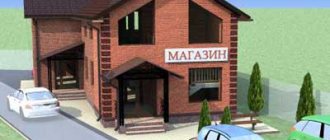Article updated: December 20, 2021
Devyatkin Alexander Land lawyer. Experience working with land plots since 2005.
Hello. The instructions on this page are suitable for any dacha (garden) plots that are registered as private property. It does not matter in which partnership (SNT, DNT, DNP, DSK, etc.) and in what locality it is located. This instruction is not suitable for areas that are leased or used. I hope this has been sorted out.
(click on the pictures to enlarge them)
A small digression - if you need a free consultation, write online to the lawyer on the right or call (24 hours a day, 7 days a week): 8 (499) 938-45-78 (Moscow and region); (St. Petersburg and region); (all regions of the Russian Federation).
To change the VRI of your summer cottage to an individual housing construction, you need to submit an application to the MFC or the Federal Registration Service for amendments to the Unified State Register of Real Estate. This is if individual housing construction for land is indicated as one of the main types of permitted use. If individual housing construction is listed as one of the conditionally permitted types of use, then to change the VRI you still need to obtain permission from the local administration.
Before doing anything at all, read the theory and requirements for translation first.
Important theory
- Each land plot has a VRI (type of permitted use) - clause 2 of Art. 7 of the Land Code of the Russian Federation and clause 4 of Art. 37 Civil Code of the Russian Federation. My article is written precisely about how to change the current type of permitted use of a site to another type, namely individual housing construction (for individual housing construction). By transferring to individual housing construction, I will mean this.
The law does not contain such type of permitted use as SNT. A gardening non-profit partnership (SNT) is a voluntary association of citizens for gardening and gardening, which is registered as a non-profit organization. Therefore, it is not specific to write about the transfer of a site “from SNT to individual housing construction.” Next I will write differently.Since 2021, dacha plots are now of only two types regarding their VRI - garden or vegetable plots (clauses 7 and 8 of Article 54 of Federal Law N 217-FZ). Now in the law there is no such thing as a summer cottage. At the same time, the owners/users of the plots do not need to change anything.
If the plot has a VRI as “dacha land plot”, “for dacha farming”, “for dacha construction”, “garden land plot”, “for gardening” or “for gardening”, it automatically becomes “garden” - p. 7 tbsp. 54 Federal Law N 217-FZ. If the plot has a VRI as “garden land”, “for vegetable gardening” and “for vegetable gardening”, it automatically becomes “garden land” - clause 8 of Art. 54 Federal Law N 217-FZ.
All of the above does not mean that plots cannot be transferred to individual housing construction. It all depends on their VRI. In 95% of cases with garden plots this is allowed. With the rest, it’s the other way around—in 95% of cases, it won’t be possible to transfer garden plots to individual housing construction. Although it is still worth checking it according to the instructions below. For now, let's talk about everything in order.
- In addition to the VRI, any plot (garden or vegetable plot) has a category according to its intended purpose - land of settlements or land for agricultural purposes (clause 1 of Article 7 of the Land Code of the Russian Federation). This is called the land category.
If a plot has the category of “land of populated areas”, then it is located in a populated area, within its borders - Art. 83 Land Code of the Russian Federation. If the site is located outside the boundaries of the settlement, then it belongs to agricultural land - Art. 77 Land Code of the Russian Federation.A plot cannot be transferred to individual housing construction if it is classified as “agricultural land”. Because individual housing construction plots can only be within the boundaries of a populated area - Art. 83 and art. 85 of the Land Code of the Russian Federation.
Is it possible to transfer a plot of land from agricultural use to residential land? Very unlikely, because everything depends on the wishes of the local administration. Only the administration of a locality, on its own initiative, can annex a nearby piece of land. Thereby changing the boundaries of the settlement and including them in the master plan - paragraphs. 3 p. 1 art. 7 and paragraph 1 of Art. 8 of the Federal Law of December 21, 2004 N 172-FZ, paragraph 1 of Art. 84 of the Land Code of the Russian Federation and clauses 1 and 2 of Art. 24 Civil Code of the Russian Federation. Naturally, they won’t do this because of one site. And it’s not a fact when several citizens turn to them. After all, the administration will have to change a lot, coordinate, supplement the infrastructure - this will take a long time and with a very small percentage of a positive outcome. Therefore, it is easier, faster and cheaper to buy another plot than to change the category of the current one. Or leave everything as is.
In any case, it is allowed to build a residential building on a garden plot, then register it as property and register - more details. In this case, it is not necessary to change to individual housing construction. It is prohibited to build on a garden plot.
You can find out the category and VRI of a plot: 1) in the title documents - in the certificate of ownership or an extract from the Unified State Register of Real Estate (formerly the Unified State Register of Real Estate). Instructions - order an extract from the Unified State Register of Land Registration; 2) on the public cadastral map of Rosreestr.
VRI and category of plot in the certificate of ownership
(click on the picture to enlarge it)
VRI and category in the extract from the Unified State Register
Other articles
Other articles about the transfer of land: from individual housing construction to private household plots; from private household plots to private housing construction; From individual housing construction to “commercial real estate”How to register ownership of a land plot
What to do if you refuse?
Refusal to assign a VRI “Individual Housing Construction” to a plot located in SNT is made in the following cases:
- An incomplete package of documents has been submitted.
- Insufficient justification for the need to transfer land from one category to another.
- Lack of consent of land co-owners.
- Discrepancy between the applicant's intentions and the general plan of the territory.
- The presence of encumbrances preventing the transfer of land.
The first three reasons are easily removable, so after finalizing the package of documents, the application can be resubmitted .
In case of reasons for refusing to satisfy the application that cannot be resolved legally, it is recommended to take advantage of the privileges of the law “On the Dacha Amnesty” - register the built house in a simplified manner and register it at the place of residence.
Requirements for translation
- The plot must be registered in the cadastral register - clause 7 of Art. 1 of the Federal Law of July 13, 2015 No. 218-FZ. Detailed instructions on how to check this - link.
- The boundaries of the site must be established in the cadastre — pp. 3 and 9 paragraph 4 art. 8 of the Federal Law of July 13, 2015 No. 218-FZ. Our instructions are how to find out if boundaries have been set.
Examples of plotsWith boundaries set
Borders are not defined
- It is necessary to take into account the minimum and maximum permitted area of the site - clauses 1 and 2 of Art. 11.9 Land Code of the Russian Federation.
The minimum and maximum size for plots is set by the local administration, based on the purpose and type of permitted use. Therefore, the permitted areas are different everywhere.For example, in the village of Ashitkovskoye, Moscow region, individual housing construction plots can range from 6 to 20 acres. Therefore, if the garden plot is 5.5 acres, it cannot be transferred to individual housing construction. After all, then it will be less than the minimum allowed size.
How to find out the permissible sizes is written below.
- If the site has several owners, they all must agree to the transfer . A general statement will be required from the owners - paragraphs. 4 paragraphs 2 art. 15 Federal Law dated July 13, 2015 No. 218-FZ. The form of ownership does not change.
- If the site is located in the Moscow region, you will have to pay to change the VRI To the Ministry of Property Relations of the Moscow Region - Resolution of the Government of the Moscow Region dated December 31, 2013 N 1190/57. In other regions they do not charge for this.
The fee is calculated from the difference in cadastral value. Individual housing construction plots always have a higher cadastral value than garden plots. About 1.7 - 2 times. Formula:10% * (KS2 - KS1).
KS1 is the current cadastral value of the plot, KS2 is the cadastral value after transfer to individual housing construction.
To find out KS2, you need to look at the cadastral values of neighboring plots of individual housing construction. Then calculate the cost of one hundred square meters and compare. The cadastral value of neighboring plots can be viewed on a public cadastral map or on the Rosreestr website - instructions with pictures.
For example, we have a garden plot of 7 acres and has a cadastral value of 2 million rubles. It turns out 285.7 thousand rubles. per hundred. Next to it there is a plot of individual housing construction of 10 acres and with a cadastral value of 3.8 million rubles. It turns out 380 thousand rubles. per hundred. If a garden plot of 7 acres is transferred to individual housing construction, its cadastral value will become 7 * 380 thousand = 2.66 million rubles. This means that when transferring you need to pay approximately 10% * (2.66 million - 2 million) = 66 thousand rubles.
How does payment work? After transferring the plot to individual housing construction, the owner will receive a payment notification from the local administration by mail within a year. You need to pay at the bank and provide them with a receipt/check. If you don't pay, they'll take it to court.
Reasons for re-registration of land
The transfer of SNT to individual housing construction is carried out for several reasons.
- SNT in the strict sense of the word does not have a postal address . The address of the partnership and the site number are indicated. Individual housing construction has a postal address - street name and house number, which corresponds to postal addressing in the Russian Post system. This complicates registration, donation, inheritance and other legal procedures.
- A building on the territory of SNT, even if it is capital and intended for permanent residence, is considered by law as a garden house. Its value cannot be higher than certain limits, which may not correspond to reality. So, before selling the plot, it is quite understandable that the owner would want to transfer SNT into individual housing construction.
- Another option is also associated with an increase in cost , but not even of the house on the site, but of the land itself. Cities are growing and at some point it may turn out that garden plots located outside the city or village end up on its territory. This simplifies connection to the centralized supply of water, gas and electricity, and improves the infrastructure of the area. Accordingly, the cost should increase. Transferring it to individual housing construction status will increase the price of the plot legally.
When moving to another category, the cadastral value of the plot changes and the property tax increases.
Features of transferring SNT to individual housing construction
The procedure for translation is almost the same. However, the timing of the transition and the possibility of failure vary depending on where the allotment is located and how it is used.
The plot is located within the boundaries of the settlements
If the site is within the city, transfer is permitted in most cases. here is quite good , and when translating this is one of the main conditions.
If a residential building has already been built , intended for year-round use, the transition is easier. The owner needs to confirm the purpose of the building and add a certificate to the package of documents.
If only a garden house is built on the land or there are no residential buildings at all , the transition is carried out only on the condition that a residential building is built on the site. If the owner does not fulfill the obligation within 5 years, he may be fined.
The plot is located on agricultural land
Garden plots are often formed outside the village boundaries. The infrastructure here , it is more difficult to provide the area with water, gas, and electricity. But at the same time, it is unlawful to call SNT agricultural land: it is still allowed to build both a garden and a residential building here.
The transition is more difficult due to many restrictions. The plot is personal property, but it is part of a partnership and in this case the legal entity is not the owner personally, but the partnership.
Transition conditions:
- all or most of the members of the partnership want to change the category;
- SNT is located in close proximity or, according to the general development plan, will soon be within the city;
- land owners have the right to re-register the land as a “residential area”.
Private household plots on the field site and SNT should not be confused. In the first case, construction is prohibited, in the second it is allowed.
The procedure for registering a garden plot for construction
Necessary:
- Draw up a declaration;
- Register ownership of the object;
- Submit documents for state registration to the Land Chamber.
Documentation
- The declaration must reflect information about:
- Type of construction - country house, kitchen, amenity room, barn, etc.;
- The materials from which the building is constructed;
- Construction area;
- Site information.
- Ownership of an object is formalized upon provision of:
- Receipt confirming payment of state duty;
- Documents regulating the right of ownership of the site;
- Declarations.
Vegetable gardening and horticulture
Legal regulation of lands intended for gardening and vegetable farming is carried out:
- Land Code of the Russian Federation;
- Law No. 66 “On gardening, gardening... associations of citizens.”
Plots with the designated purpose of “gardening” are intended for growing various agricultural crops and for the construction of permanent residential buildings, according to Art. 1 Federal Law No. 66.
Vegetable garden plots, unlike garden plots, are intended only for growing agricultural plants. The construction of permanent housing on garden plots is prohibited; only the installation of temporary cabins and auxiliary buildings without a foundation is possible.
Price
The administrative procedure for changing the type of permitted use of a garden plot to individual housing construction is carried out free of charge .
At the same time, a fee is charged for the preparation of some documents included in those required by the body authorized to carry out the procedure.
Additional procedures and their costs:
- Registration of cadastral extracts - up to 750 rubles. - for citizens, up to 2200 rubles - for representatives of enterprises and individual entrepreneurs.
- Measurement of a plot with registration in Rosreestr - from 7,000 rubles. Prices vary depending on the region of work.
- Registration of changes in the State Cadastre - up to 350 rubles. — for citizens, up to 1000 rubles. for commercial structures, depending on the form of information provision.
The services of a lawyer will help facilitate the procedure.
The specialist will ensure legal examination of documents and their timely submission for consideration by the authorized authority. The cost of services may increase by 20,000-50,000 rubles .
Reasons and grounds for refusal
Why an applicant may be refused:
- the application was written and submitted by a person who does not actually have such rights (not the owner, not the tenant, not the perpetual user);
- the submitted documents have blots, inaccuracies, damage, not all of them or do not meet the accepted requirements;
- the indicated plot is actually located far away, there are no settlements nearby, so it is impossible to transfer it to individual housing construction (it is worth remembering that all individual housing construction must be located next to some town or village);
- an environmental assessment suddenly issued a negative conclusion - this happens if construction may in the future cause some harm to the natural environment surrounding the site;
- special land - some plots look like an ordinary wasteland, others, on the contrary, look like full-fledged pastures or lush meadows, then the administration will consider the transfer irrational.
Features from Chapter 2 of the Federal Law “On Land Transfer”
In particular, with regard to agricultural plots, the law provides for the possibility of changing their specialization under the following conditions:
- land conservation will be carried out;
- the site is included in the environmental protection area;
- the city limits are being transferred;
- on areas recognized as unsuitable for agricultural activities, industrial buildings will be erected or they will be used for other needs not related to agriculture;
- areas unsuitable for agricultural activities will subsequently be classified as forest fund, reserve lands or water fund;
- if in the allocated areas it is planned to build highways, power lines, communication lines (including linear cable structures), pipelines for various purposes, railway tracks and other linear objects. The condition is valid in the case when the cost of plots with agricultural land, according to the cadastre, is more than 30% lower than the regional average, and the planned linear objects will be built in close proximity to roads and the extreme line of crop rotation fields;
- in connection with the need to fulfill the international obligations of the Russian Federation, to maintain defense capability and ensure state security guarantees; in connection with the possibility of extracting minerals from the subsoil (common type minerals are an exception);
- in order to preserve monuments of historical and cultural heritage, construction of diverse facilities for social, cultural, educational and other purposes.
The law limits the targeted transfer of plots from an agricultural category to any other if they contain valuable land with increased agricultural productivity. Also, when considering the application, a comparative assessment of the current cadastral value of land plots is carried out, in which the average value for the region is taken as a guide.
When transferring lands previously used by industrial enterprises, the energy and transport industries, were involved in the telecommunications, broadcasting, space industries, and were also at the disposal of the Ministry of Defense, there are no significant restrictions, except for several features:
- When transferring land plots from industrial or other types of use, the factor of soil contamination and the presence of structures and buildings designated for demolition are taken into account. Before changing the category in this case, it is necessary to develop and approve a project aimed at land reclamation;
- if on land plots that were previously classified as industrial or special purpose, activities that negatively affected the composition and quality of the soil layer require a series of measures to restore the soil, in accordance with the approved reclamation plan.
If the application to transfer land from the industrial category was submitted by executive authorities or local municipalities, preliminary reclamation is not a mandatory condition for the transfer.
For land plots included in the environmental category, the transfer is carried out after a preliminary environmental examination conducted by the state, as well as other examinations, the conduct of which is determined by current federal laws related to environmental protection.
WHAT IS THE RESULT OF THE PETITION?
Based on the results of consideration of the application, the local government body adopts an act on the transfer of lands or land plots as part of such lands from one category to another or an act on refusal to transfer lands or land plots as part of such lands from one category to another within two months from the date of receipt petitions.
An act on the transfer of lands or land plots or an act on refusal to transfer lands or land plots is sent to the interested person within fourteen days from the date of adoption of such an act.
An act on the transfer of lands or land plots or an act on refusal to transfer lands or land plots may be appealed in court.
How we are working
Our company has a well-established scheme for performing work. This allows us to provide guarantees and reduce terms as much as possible. The translation is carried out in several stages:
- Initial consultation, familiarization with the package of documents. Our experts meet with the client and study his tasks. We take a comprehensive look at the problem and, if possible, offer several solutions. The cost of transferring land from gardening to individual housing construction and the timing of the work are immediately discussed. If the client is satisfied with everything, we sign an official contract.
- Collecting missing documents, filling out an application. If possible, we will independently receive copies of certificates and extracts instead of you (a power of attorney will be issued to the lawyer).
- Submission of documents to the administration. As a rule, consideration of the application takes from one to two months.
- If the decision is positive, assistance in re-registration of documents for the dacha. If necessary, our lawyers will also help you obtain permission to build a house in a short time.
- If the decision is negative, analyze the reasons for the refusal and search for ways to eliminate them. If the administration's decision is unreasonable, lawyers can file a lawsuit.
Peculiarities
Land for growing garden crops can be for individual or collective use. Each land use option has its own characteristics.
The location of garden plots on a particular category of land determines the sequence of administrative procedures for changing the type of permitted use:
- Garden lands as part of settlements - an application to change the VRI is sent to the relevant executive authority.
- Vegetable gardens on agricultural land - a change in the category of land is carried out with the simultaneous assignment of the desired VRI to the plot. The petition is sent to the local administration, then, after assessing the feasibility of the upcoming procedure, it is forwarded to the body of the subject of the Federation responsible for the provision of public services.
When using a plot collectively, it is necessary to obtain the consent of all plot owners .








